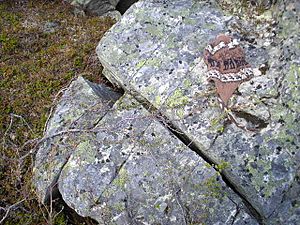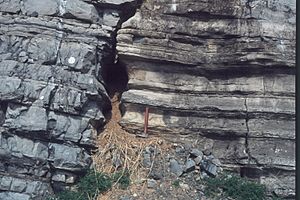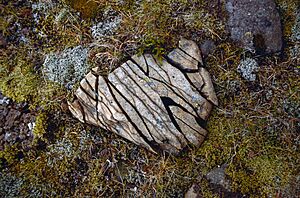Weathering facts for kids
Weathering is how rocks, soil, and minerals break down over time. It happens when they touch the Earth's air, water, or living things. This is a natural process that constantly shapes our planet.
It's important to know that weathering happens right where the rock is. It's different from erosion, which is when broken-down pieces of rock and soil are moved away by things like ice, water, wind, or gravity.
Contents
How Rocks Break Down Physically
Physical weathering, also called mechanical weathering, is when rocks and minerals break into smaller pieces. Their chemical makeup stays the same. It's like breaking a cookie into crumbs; it's still a cookie, just smaller.
Wind Power
Wind can be a strong force. It blows water or tiny particles like sand against rocks. Over a long time, this constant hitting can wear down and break the rock's surface.
Rain's Gentle Force
Rain might seem soft, but it also works slowly to break down rocks. The force of raindrops hitting some rocks can make them wear away. Rainwater is also slightly acidic, which can cause small chemical changes in certain rocks. This helps break them down even more.
Temperature Changes
Big changes in temperature can make a rock crack. When the sun shines on a rock, its surface gets hot and expands a little. The inside of the rock stays cooler. At night, the surface cools down and shrinks. This constant expanding and shrinking weakens the rock's surface, eventually causing cracks.
Also, if water gets into a crack in a rock and the temperature drops below freezing, the water turns into ice. When water freezes, it expands. This expansion pushes on the crack, making it bigger. After many times of freezing and thawing, the rock can break into pieces. This is called freeze-thaw weathering.
Ice Grinding Rocks
Huge sheets of ice, like those in a glacier, can be miles thick. As they move, these massive ice bodies grind against the rock below them. They pick up and carry along rock particles. When a glacier reaches the sea, all the material it carried is dropped there.
Lava and Magma's Heat
When very hot molten rock, called lava (on the surface) or magma (underground), touches older rocks, it can cause weathering. The extreme heat makes the older rock change its structure, sometimes forming new types of crystals.
How Rocks Break Down Chemically
Chemical weathering happens when rocks break down and their chemical composition changes. It's like sugar dissolving in water; it's still there, but it's changed form.
The Carbon Dioxide Cycle
The carbon dioxide cycle is very important for chemical weathering. Carbon dioxide (CO2) enters the air mostly from volcanoes. It's removed by plants through photosynthesis and by other natural processes.
When CO2 is in the air, it can mix with water droplets to form a weak acid called carbonic acid. When this acidic rain falls on rocks, it slowly dissolves many types of minerals and rocks. For example, when a mineral like feldspar dissolves, it releases sodium into the sea. Other minerals release chlorine. This is why the sea tastes salty – it's full of elements that have dissolved out of rocks over millions of years.
Related pages
Images for kids
-
A natural arch formed by erosion of different rock layers in Jebel Kharaz, Jordan.
-
Pyrite cubes that have been oxidized (rusted).
-
Salt weathering on sandstone near Qobustan, Azerbaijan.
-
This Permian sandstone wall near Sedona, Arizona, has weathered into a small alcove.
-
The effect of acid rain weathering on statues.
See also
 In Spanish: Meteorización para niños
In Spanish: Meteorización para niños



















